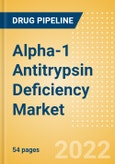Alpha-1 antitrypsin deficiency (AATD) is an inherited disease that causes an increased risk of chronic obstructive pulmonary disorder (COPD), hepatic failure, skin problems (panniculitis), and inflammation of the blood vessels (vasculitis).
The current treatment options for AATD are alpha-1 proteinase inhibitor (A1-PI) therapies, which provide the alpha-1 antitrypsin (AAT) protein that prevents the overproduction of elastase in lung tissue.
The 2MM market (US and Germany) is expected to grow from $1.2 billion in 2021 to $3.48 billion in 2031 at a CAGR of 11.2%. The introduction of 4 new pipeline agents are key drivers of this market growth.
Report deliverables include a PowerPoint report and Excel-based forecast model
Forecasts include two countries
Forecasts cover three time points: base year, 5-year, and 10-year
The current treatment options for AATD are alpha-1 proteinase inhibitor (A1-PI) therapies, which provide the alpha-1 antitrypsin (AAT) protein that prevents the overproduction of elastase in lung tissue.
The 2MM market (US and Germany) is expected to grow from $1.2 billion in 2021 to $3.48 billion in 2031 at a CAGR of 11.2%. The introduction of 4 new pipeline agents are key drivers of this market growth.
Report deliverables include a PowerPoint report and Excel-based forecast model
Forecasts include two countries
Forecasts cover three time points: base year, 5-year, and 10-year
- The prevalence of AATD is increasing at a steady rate, in line with population growth in the 2MM at an AGR of 1.07%
- Currently, the treatment regimen for AATD in the 2MM is entirely limited to the four marketed alpha-1 proteinase inhibitors
- There are several unmet needs in this space, including the need for early diagnosis of AATD and novel therapies with improved efficacy
- The AATD late-stage R&D pipeline is focused on developing a novel AI-PI, NE inhibitor therapies, and RNAi therapies
- Significant growth is expected throughout the forecast period as the AATD population steadily increases and novel therapies enter the market
Scope
- Overview of AATD, including epidemiology, symptoms, diagnosis, and disease management
- Annualized AATD therapeutics market revenue, annual cost of therapy and treatment usage pattern in 2021 and forecast for ten years to 2031
- Key topics covered include strategic competitor assessment, market characterization, unmet needs, clinical trial mapping and implications for the AATD therapeutics market
- Pipeline analysis, comprehensive data assessing emerging trends and mechanisms of action under development for AATD treatment. The most promising candidates in late-stage development are profiled
- Analysis of the current and future market competition in the global AATD therapeutics market. Insightful review of the key industry drivers, restraints, and challenges. Each trend is independently researched to provide a qualitative analysis of its implications
Reasons to Buy
- Develop and design your in-licensing and out-licensing strategies through a review of pipeline products and technologies, and by identifying the companies with the most robust pipeline
- Develop business strategies by understanding the trends shaping and driving the global AATD therapeutics market
- Drive revenues by understanding the key trends, innovative products and technologies, market segments, and companies likely to impact the global AATD therapeutics market in the future
- Formulate effective sales and marketing strategies by understanding the competitive landscape and by analyzing the performance of various competitors
- Identify emerging players with potentially strong product portfolios and create effective counterstrategies to gain a competitive advantage
- Organize your sales and marketing efforts by identifying the market categories and segments that present maximum opportunities for consolidations, investments, and strategic partnerships
Table of Contents
1 Executive Summary1.1 Executive Summary
2 Disease Overview
2.1 Overview of Alpha-1 Antitrypsin Deficiency (AATD)
2.2 AATD SWOT Analysis
2.3 Classification of AATD
3 Epidemiology
3.1 Diagnosed Prevalent Cases of Alpha-1 Antitrypsin Deficiency, Men and Women, 2021-31
3.2 Sources and Methodology
4 Current Treatment Options
4.1 Treatment Paradigm
4.2 Marketed Products
4.3 Product Profiles: Alpha-1 Proteinase Inhibitors (Glassia, Prolastin-C, Zemaira/Respreeza, Aralast NP)
5 Unmet Needs and Opportunities
5.1 Unmet Needs in AATD
5.2 Earlier AATD Disease Diagnosis
5.3 AATD Treatments with Improved Efficacy
5.4 Reduced Cost for AATD Treatments
5.5 Treatment Dosage for AATD Patients
5.6 Patient Compliance
6 Pipeline Assessment
6.1 AATD Pipeline Overview
6.2 Leading Pipeline Agents
6.3 Product Profiles: Alpha-1 proteinase inhibitor (human) second generation, PHP-303, Alvelestat, Belcesiran, ARO-AAT (Fazirsiran Sodium)
6.4 Pipeline Products - Review Designations
6.5 AATD: Clinical Trials (Phase II/III) Overview
7 R&D Strategies
7.1 Trends in Clinical Trial Design in AATD
7.2 Trends in Deal-Making in AATD
8 Market Outlook
8.1 AATD Sales Forecast
8.2 AATD Market Forecast
8.3 Market Drivers and Barriers
9 Appendix
9.1 Primary Research: KOL Information
9.2 About the Authors
10 Contact the Publisher








